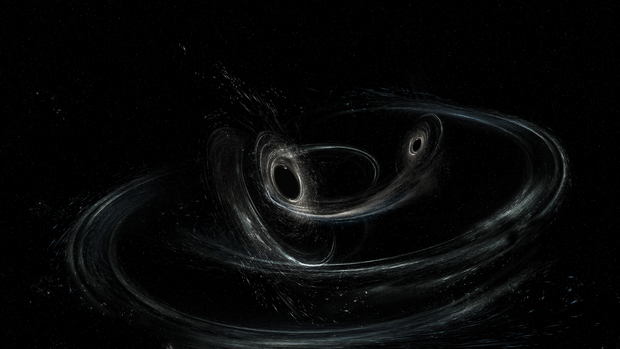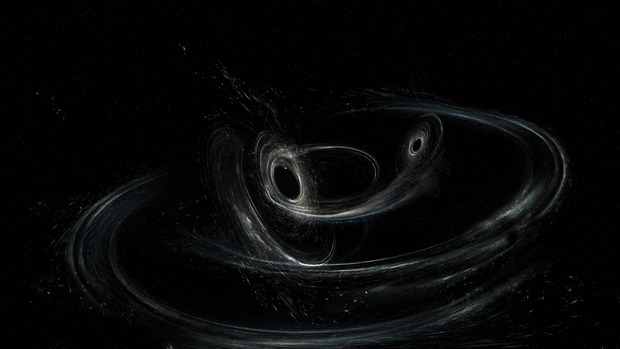What We Have Covered in This Article
Last Updated on July 21, 2017 by Editor Futurescope
3 billion years ago, long before multicellular life existed on our planet, two black holes merged into a violent explosion. The collision generated very faint “echoes” that moved through the cosmos, as it happens when we throw a stone at a pond and observe the waves that occur in the water. An international team of scientists has been able to detect for the third time gravitational waves, the “echoes” formed after the black holes devour one another, thanks to the Gravitational Wave Laser Interferometry Observatory (LIGO).
What are gravitational waves and why are they important?
For the third time, the LIGO gravitational observatory of laser interferometry in the United States has detected the gravitational waves predicted by Albert Einstein in his Theory of General Relativity. These are disturbances of space time, ripples that are formed when very violent events occur in the Universe, such as the merger of black holes or explosions of supernovae. The confirmation of its detection was announced in February 2016 (the first observation was made on September 14, 2015 and the second, in December of that year) and was revolutionary news for astronomers, because the gravitational waves were the only part of Einstein’s theory that had not yet been demonstrated with direct observations. With them, say the scientists, a new form of astronomy was born, of looking at the cosmos, with which they hope to know more about the mysterious nature of black holes and dark matter.
As in the first two detections, the gravitational waves that have been captured on this occasion come from the fusion of two black holes. The third (named GW170104) occurred on January 4. The new black hole formed after that collision has a mass of 49 times that of the Sun, which places it in the middle of the two previous events. The first detection was 62 times the mass of the Sun and the second, 21. This violent crash, the details of which will be published in the journal Physical Review Letters, occurred 3 billion light years. Farther away than the other explosions detected at the LIGO Observatory (comprising two US observatories in Livingston and Hanford). The first crash took place at 1.3 billion light years and the second, at 1.4 billion light years. “It is extraordinary that humans can assemble a story and test it on events so extreme and strange that happened billions of years ago and billions of light years away from us,” said David Shoemaker, MIT researcher and new representative of the LIGO collaboration, in which around a thousand scientists from different centers work. The current campaign of observations, which is part of this third detection, began on November 30 and will continue until the end of the summer.
In a statement, the director of the National Science Foundation (NSF), France Córdova, explained that this detection is framed within the expectations of its organization: “LIGO is taking us ever more far in space and time, In ways that we could not before the detection of gravitational waves, in this case, we are exploring something [happening] to about 3 billion light-years! “He says. “We know that this is just the beginning.This window to the Universe will continue to expand.” Binary Black Hole Systems “The first observation showed that this phenomenon of gravitational waves exists and that LIGO worked correctly.In addition, as two black holes colliding “Said Carlos F. Sopuerta, a senior researcher at the University of California, Berkeley, in a telephone interview. Of the Institute of Space Sciences (CSIC-IEEC) in the LISA Pathfinder mission of the European Space Agency (ESA). “In addition, the first detection showed that one of the black holes [involved in that collision] had a mass 32 times that of the Sun, and that figure was well above what we thought a black hole of stellar origin might have Comes from the death of a star, the other was 29 times the mass of the Sun, “says Sopuerta. And, until then, it was thought that these objects could not have more than 20 times the mass of the Sun. The results obtained by Ligo, adds the Spanish researcher, have also led to “speculations, for example, that instead Of being the result of the death of a star, a black hole, could be made up of dark matter.”
According to Susan Scott, a professor at the National University of Australia (ANU), this finding is the first proof that black holes in binary systems may not be aligned: “It means that the two black holes could Be rotating in different directions, which is a clue as to how that binary system might have formed, “says Scott, one of the scientists involved in the LIGO project.
Two Main Models On Their Experiment


There are two main models to explain how binary pairs of black holes were formed. The first model proposes that black holes are born together: they form when each star, of a pair, explodes, and then, due to the aligned rotation of the original stars, the black holes remain aligned.
In the other model, the black holes are joined later in stellar clusters. They pair after sinking the center of a star cluster. In this scenario, black holes can rotate in any direction with respect to their orbital motion. Precisely, LIGO sees evidence that GW170104 are not aligned, which means that these data are tilted slightly in favor of this theory of stellar clusters.
The study again confirms Albert Einstein’s theories. For example, researchers looked for an effect called dispersion that occurs when light waves in a physical medium – such as a vessel– travel at different speeds depending on their wavelength; this is how a prism forms a rainbow. Einstein’s general theory of relativity forbids the dispersal of what happens in gravitational waves, since they propagate from their source to the Earth, but LIGO did not find evidence of this effect.
Albert Einstein is right again
“It seems that Einstein was right, even for this new event, which is about twice as far as our first detection,” says Laura Cadonati of Georgia Tech, deputy spokeswoman for the LSC. “We can not see any deviation from the predictions of general relativity, and this distance helps us make that statement more confidently,” he adds.
“The instruments of LIGO have reached impressive sensitivities,” said Jo van den Brand, a physicist at the Dutch National Institute for Subatomic Physics (Nikhef) and professor at the VU University in Amsterdam. “We hope this summer Virgo, the European interferometer, will expand the detector network, helping us locate better signals,” he says.
The LIGO-Virgo team continues to search for the latest space-time wave signal data from the distant cosmos. They are also working on technical improvements for the following LIGO observation, scheduled to begin in late 2018.
“With the third confirmed detection of gravitational waves from the two-hole collision, LIGO is consolidating itself as a powerful observatory to reveal the dark side of the universe,” said LIGO Laboratory CEO David Reitze of Caltech. “While LIGO is especially suited for observing such events, we expect to see other astrophysical events soon, such as the violent collision of two neutron stars,” Reitze concludes.
They detect gravitational waves for the third time and a new black hole of 49 times the size of the Sun
The Gravitational Wave Observatory Laser Interferometer (LIGO) has made a third detection of gravitational waves – states in space and time -, which opens a new window in the field of astronomy. As in the case of the first two, the waves were generated when two black holes collided to form a larger black hole.
This third detection, called GW170104, occurred on January 4, 2017. The first observation of gravitational waves of LIGO took place in September of 2015, during its first observation, while the second one occurred in December of 2015.
“We have confirmation of the existence of black masses of stellar mass that are larger than 20 solar masses. These are objects that we did not know existed before LIGO detected them,” says David Shoemaker of MIT, spokesman for the Scientific Collaboration LIGO (LSC), made up of more than 1,000 international scientists working in collaboration with the European Virgo project.
“It is noteworthy that humans can unite a story and test it for this kind of strange and extreme events that took place billions of years ago and billions of light years from Earth. LIGO and Virgo scientific collaborations have worked to unite All pieces, “says Shoemaker.
The new detection occurred during the current operation of the LIGO observation, which began on November 30, 2016, and will continue until the summer. The observations are carried out by double detectors – one in Hanford, Washington, and the other in Livingston, Louisiana – which are operated by Caltech and MIT with funding from the National Science Foundation (NSF).
In all three detections, each of the detectors picked up gravitational waves from the tremendously energetic fusions of pairs of black holes. These are collisions that produce more energy that radiates as light through all the stars and galaxies in the Universe at any given time.
This third finding appears to be the most distant detection of all three, with black holes located about three billion light-years. The black holes in the first and second detections are respectively 1.3 and 1.4 billion light-years away.
The new observation also provides clues about the directions in which black holes spin. As pairs of black holes spin around each other in a spiral, they also rotate on their own axes. Sometimes black holes spin in the same general orbital direction when the pair is moving – what astronomers refer to aligned turns. And sometimes they turn in the opposite direction to the orbital movement. In addition, black holes can line up away from the orbital plane. In essence, black holes can rotate in any direction.
The new LIGO data cannot determine whether the newly observed black holes were aligned, but suggest that at least one of the black holes might not have been aligned with the overall orbital motion. More observations are needed to say something definitive about the binary black hole turns, but these recent data provide clues as to how these pairs might have formed.
The confirmed detection of the third gravitational wave, which originated after the collision of two black holes, shows that LIGO is a very powerful observatory to unveil “the dark side of the universe,” according to Dr. David Reitze, a Caltech scientist and director Executive of the collaboration. According to Sintes, the results prove “that from now on we will continue to observe more events”. No doubt, we are in the beginning of an era, starring astronomy of gravitational waves, in which we have a powerful tool to observe the cosmos. Thanks to Advanced LIGO, it is possible to hear the “echoes” caused by some of the most exotic and violent phenomena in the universe.







